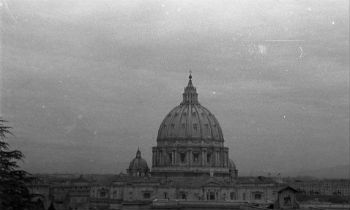We ask you, urgently: don't scroll past this
Dear readers, Catholic Online was de-platformed by Shopify for our pro-life beliefs. They shut down our Catholic Online, Catholic Online School, Prayer Candles, and Catholic Online Learning Resources essential faith tools serving over 1.4 million students and millions of families worldwide. Our founders, now in their 70's, just gave their entire life savings to protect this mission. But fewer than 2% of readers donate. If everyone gave just $5, the cost of a coffee, we could rebuild stronger and keep Catholic education free for all. Stand with us in faith. Thank you.Help Now >
When bombs fell on the Vatican
FREE Catholic Classes
It was a dark autumn night in Rome, which was suffering under the occupation of Nazi Germany and was the target of bombing raids by Allied and Axis forces.

St. Peters Basilica in 1940
Highlights
Catholic Online (https://www.catholic.org)
11/6/2019 (6 years ago)
Published in Europe
Keywords: WAR, VATICAN CITY, VATICAN
Vatican City, (CNA) - It was a dark autumn night in Rome, which was suffering under the occupation of Nazi Germany and was the target of bombing raids by Allied and Axis forces.
The Vatican City State was a neutral territory in World War II, but shortly after 8:00 pm on Nov. 5, 1943, a small non-descript plane dropped five bombs onto the Vatican.
Only four detonated -- the first went off near the Vatican train station, a second exploded on the mosaic workshop of the Vatican Museums destroying some of the pieces inside, a third damaged offices within the building of the governorate, and a fourth exploded in the ground outside the Santa Marta guesthouse, causing glass in a rear window of St. Peter's Basilica to shatter.
No one was hurt, but until the last decade the bombing was shrouded in mystery, because there was not a lot of information about who carried out the attack and why.
At the time, Rome was occupied by German forces and was part of the Italian Social Republic, a German puppet state nominally led by Benito Mussolini.
Mussolini's government accused the United States of having dropped the bombs, and the fascist press accused the Allies.
In a 2010 book, author Augusto Ferrara published documentation which showed that immediately following the bombing, the Secretariat of State convened an inquiry into the source of the attack, sending letters requesting explanation to Germany, the U.S., and Great Britain. Blame for the raid was denied by all three.
But the investigation uncovered that the bombs were dropped from a S.79 aircraft supplied by the Italian Social Republic, which had departed from the airport of Viterbo, about 50 miles north of Rome.
Documentation in the Italian-language book, titled "1943. Bombe sul Vaticano," shows the bombing was ordered by Roberto Farinacci, a fascist politician and advisor to Mussolini who wanted to destroy Vatican Radio because he thought it was transmitting military information to the "enemy."
The Sunday immediately following the attack, Venerable Pius XII addressed people in St. Peter's Square, explaining what happened and that an investigation was underway. But when it was revealed that it was likely done by a fascist leader, he asked for it to be kept out of the newspapers, since Italy was still at war.
After the Nov. 5 raid, the Vatican was hit once again, on March 1, 1944, when a British plane accidentally dropped its bombs too nearby and hit the Vatican wall, killing a Vatican workman and injuring a religious, as well as shattering the windows of the building of the Congregation for the Doctrine of the Faith.
In May 1943, after the first bombs were dropped on Rome by Allied forces, Ven. Pius XII had written to U.S. President Franklin Roosevelt asking him as much as possible to spare Rome "further pain and devastation" and to keep Rome's treasured shrines "from irreparable ruin."
Roosevelt replied June 16, 1943, saying, "attacks against Italy are limited, to the extent humanly possible, to military objectives."
"In the event it should be found necessary for Allied planes to operate over Rome, our aviators are thoroughly informed as to the location of the Vatican and have been specifically instructed to prevent bombs from falling within Vatican City."
Despite this, heavy raids were carried out on Rome before it was captured by the Allies June 4, 1944. Among these was the devastating bombing of July 19, 1943, in which thousands of civilians were killed.
The same day, after the raid ended, Ven. Pius XII and the future Pope Paul VI (then Secretariat of State Archbishop Giovanni Montini) traveled to the area most-affected, the San Lorenzo neighborhood, to hand out money to the crowds gathered in front of San Lorenzo fuori le Mura.
---
'Help Give every Student and Teacher FREE resources for a world-class Moral Catholic Education'
Copyright 2021 - Distributed by Catholic Online
Join the Movement
When you sign up below, you don't just join an email list - you're joining an entire movement for Free world class Catholic education.
An Urgent Message from Sister Sara – Please Watch
- Advent / Christmas
- 7 Morning Prayers
- Mysteries of the Rosary
- Litany of the Bl. Virgin Mary
- Popular Saints
- Popular Prayers
- Female Saints
- Saint Feast Days by Month
- Stations of the Cross
- St. Francis of Assisi
- St. Michael the Archangel
- The Apostles' Creed
- Unfailing Prayer to St. Anthony
- Pray the Rosary
![]()
Copyright 2025 Catholic Online. All materials contained on this site, whether written, audible or visual are the exclusive property of Catholic Online and are protected under U.S. and International copyright laws, © Copyright 2025 Catholic Online. Any unauthorized use, without prior written consent of Catholic Online is strictly forbidden and prohibited.
Catholic Online is a Project of Your Catholic Voice Foundation, a Not-for-Profit Corporation. Your Catholic Voice Foundation has been granted a recognition of tax exemption under Section 501(c)(3) of the Internal Revenue Code. Federal Tax Identification Number: 81-0596847. Your gift is tax-deductible as allowed by law.









